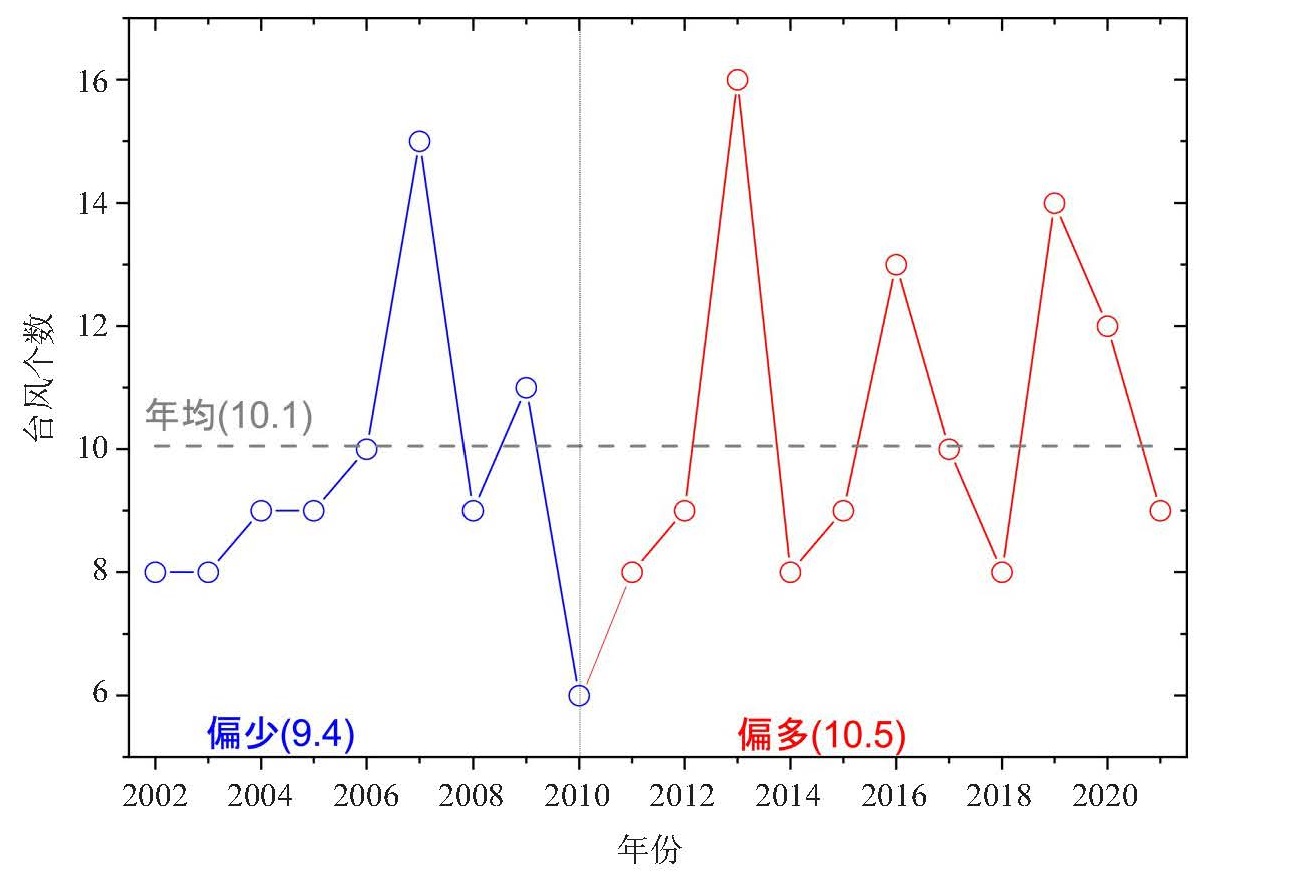Characteristics of Autumnal Typhoons over the Western North Pacific During 2002-2021
-
摘要: 基于中国气象局上海台风研究所台风年鉴资料,分析近二十年(2002—2021年)西北太平洋(WNP)秋季(9—11月)台风的频数、强度、位置、路径及其年际变化和季节内差异,以及登陆我国的秋季台风的风雨特点。结果表明,近二十年秋季WNP共生成201个台风(其中39个登陆我国,占比19.4%),以超强台风(25.9%)和强台风(21.9%)居多。2010年之前WNP秋季台风个数偏少(9.4个/年)、但登陆我国的比例较高(25.8%),之后转为个数偏多(10.5个/年)、但登陆我国比例下降(14.7%),总体趋势不显著。二十年间WNP每年秋季平均约1.95个台风登陆我国,其中强台风和超强台风占61.5%,年际变化呈现2010年之前偏多快变、之后偏少稳定的特征。秋季登陆我国的台风主要影响海南、广东、台湾,其最大观测风速和最大单站过程降雨量总体呈线性关系,即最大观测风速越大最大单站过程降雨量越强,但两者的趋势变化都不显著。相比而言,秋季登陆广东的台风最大观测风速最高、最大单站过程降雨量最强。Abstract: Utilizing the annual typhoon data from the Shanghai Typhoon Institute of the China Meteorological Administration, this study examined the frequency, intensity, location, track, interannual variation, and intra-seasonal differences of typhoons over the Western North Pacific (WNP) during autumn (September to November) from 2002 to 2021, with a focus on those making landfall in China and the features of heavy precipitation and strong wind observed during typhoon landing processes. The findings reveal that of the 201 typhoons formed in the WNP during autumn in these twenty years, 39 made landfall in China, representing 19.4% of the total and predominantly consisting of super typhoons (25.9%) and strong typhoons (21.9%). Before 2010, the number of autumnal typhoons was relatively low (9.4 per year), but the proportion of those making landfall in China was high (25.8%). After 2010, the annual number of typhoons increased (10.5 per year), but the proportion of those making landfall in China decreased (14.7%), with no significant overall trend. On average, about 1.95 typhoons made landfall in China each autumn, with super and strong typhoons together accounting for 61.5% of them. The interannual variation showed a pattern of rapid fluctuations before 2010, followed by a more stable and reduced number of landfalls after 2010. Autumnal typhoons that made landfall primarily affected Hainan, Guangdong, and Taiwan provinces, with the maximum observed wind speed and the maximum single-station rainfall generally exhibiting a linear correlation, implying that higher wind speeds correspond to heavier rainfall. However, the trends in both variables were not significant. In comparison, autumnal typhoons making landfall in Guangdong Province exhibited the highest maximum observed wind speed and the most intense single-station rainfall.
-
表 1 2002—2021年WNP秋季台风逐月生成个数
月份 总数/个 年平均/个 占比/% 9月 91 4.6 45.3 10月 68 3.4 33.8 11月 42 2.1 20.9 秋季(9—11月) 201 10.1 - 表 2 2002—2021年WNP秋季台风强度统计
台风强度 总数/个 年平均/个 占比/% 热带风暴 39 1.95 19.4 强热带风暴 33 1.65 16.4 台风 33 1.65 16.4 强台风 44 2.2 21.9 超强台风 52 2.6 25.9 表 3 2002—2021年WNP秋季登陆我国的不同强度台风的频次
登陆台风强度 登陆台风数/个 年平均/个 占比% 9月 10月 11月 合计 热带风暴 5 2 0 7 0.35 17.9 强热带风暴 3 1 0 4 0.2 10.3 台风 2 1 1 4 0.2 10.3 强台风 7 2 1 10 0.5 25.6 超强台风 10 4 0 14 0.7 35.9 表 4 2002—2021年WNP秋季登陆我国的台风登陆地逐月统计
省份 登陆情况 9月/个 10月/个 11月/个 浙江 首次登陆 2 0 0 二次登陆 1 0 0 浙闽交界 首次登陆 0 0 0 二次登陆 0 1 0 福建 首次登陆 3 1 0 二次登陆 3 0 0 广东 首次登陆 6 3 0 二次登陆 1 1 0 广西 首次登陆 0 0 0 二次登陆 1 0 0 海南 首次登陆 9 4 1 二次登陆 0 0 0 台湾 首次登陆 7 2 1 二次登陆 0 0 0 -
[1] 陈文方, 端义宏, 陆逸, 等. 热带气旋灾害风险评估现状综述[J]. 灾害学, 2017, 32(4): 146-152. [2] 李绍攀, 赵飞, 周义棋, 等. 基于微博数据灾害舆情分析与灾害损失估计[J]. 清华大学学报(自然科学版), 2022, 62(1): 43-51. [3] YAO X P, ZHAO D J, LI Y. Autumn tropical cyclones over the western North Pacific during 1949-2016: A statistical study[J]. J Meteor Res, 2020, 34(1): 150-162. [4] CHAN J C L. Interannual and interdecadal variations of tropical cyclone activity over the western North Pacific[J]. Meteor Atmos Phys, 2005, 89: 143-152. [5] 陈联寿, 端义宏, 宋丽莉, 等. 台风预报及其灾害[M]. 北京: 气象出版社, 2012. [6] 高歌, 黄大鹏, 赵珊珊. 基于信息扩散方法的中国台风灾害年月尺度风险评估[J]. 气象, 2019, 45(11): 1 600-1 610. [7] 赵珊珊, 李莹, 赵大军, 等. 2001—2020年中国月尺度热带气旋灾害时空变化特征研究[J]. 气候变化研究进展, 2023, 19(5): 592-604. [8] ZHAO S, GAO G, SUN X, et al. Climatological characteristics of tropical cyclones in the Northwestern Pacific[J]. J Appl Meteor Sci, 2009, 20(5): 555-563. [9] HU C, ZHANG C, YANG S, et al. Perspective on the northwestward shift of autumn tropical cyclogenesis locations over the western North Pacific from shifting ENSO[J]. Climate Dyn, 2017, 51: 2 455-2 465. [10] 陈博, 周凤才, 徐明, 等. 我国秋季台风与相邻气团相互作用的天气气候特征分析[J]. 安徽农业科学, 2016, 44(29): 196-198, 221. [11] LIU K S, CHAN J C L. Climatological characteristics and seasonal forecasting of tropical cyclones making landfall along the South China coast[J]. Mon Wea Rev, 2003, 131(8): 1 650-1 662. [12] GRAY W M. Global view of the origin of tropical disturbances and storms[J]. Mon Wea Rev, 1968, 96(10): 669-700. [13] DEMARIA M. The effect of vertical shear on tropical cyclone intensity change[J]. J Atmos Sci, 1996, 53(14): 2 076-2 087. [14] WU L, ZHANG H, CHEN J, et al. Impact of two types of El Niño on tropical cyclones over the western North Pacific: Sensitivity to location and intensity of Pacific warming[J]. J Climate, 2018, 31(5): 1 725-1 742. [15] HIROSHI G, TAKAHASHI, YOSHIKI FUKUTOMI, et al. The impact of long-lasting northerly surges of the East Asian winter monsoon on tropical cyclogenesis and its seasonal march[J]. J Meteor Soc Japan, 2011, 89A: 181-200. [16] 朱塞智, 孟祥凤. 两类El Niño Modoki事件时西北太平洋秋季热带气旋生成地的差异[J]. 海洋环境科学, 2015, 34(2): 255-260. [17] 刘婧茹. 中国东南地区热带气旋影响下伴随不同天气的大风特性[D]. 中国气象科学研究院, 2023. [18] 杨玉华, 雷小途. 我国登陆台风引起的大风分布特征的初步分析[J]. 热带气象学报, 2004(6): 633-642. [19] 陆逸, 朱伟军, 任福民, 等. 1980—2014年中国台风大风和台风极端大风的变化[J]. 气候变化研究进展, 2016, 12(5): 413-421. [20] 陈联寿, 罗哲贤, 李英. 登陆热带气旋研究的进展[J]. 气象学报, 2004, 62(5): 541-549. [21] 黄奕武, 端义宏, 余晖. 地形对超强台风罗莎降水影响的初步分析[J]. 气象, 2009, 35(9): 3-10. [22] 钮学新, 董加斌, 杜惠良. 华东地区台风降水及影响降水因素的气候分析[J]. 应用气象学报, 2005(3): 402-407. [23] 王毅, 张晓美, 杨寅, 等. 1617号鲇鱼台风登陆后引发不同性质暴雨的成因对比分析[J]. 大气科学学报, 2019, 42(2): 245-254. [24] 范爱芬, 彭霞云, 娄小芬, 等. 秋季台风倒槽特大暴雨的对流特征和预报难点分析[J]. 暴雨灾害, 2022, 41(3): 298-307. [25] 李柯薇, 张奡祺, 黎伟标. 西北太平洋热带气旋强度变化对雨带分布特征影响[J]. 热带气象学报, 2023, 39(5) 764-773. [26] 黄莉, 白龙, 李紫甜. 适当冷空气对秋季台风暴雨增幅作用研究[J]. 灾害学, 2018, 33(2): 38-44. [27] HSU P C, CHU P S, MURAKAMI H, et al. An abrupt decrease in the late-season typhoon activity over the western North Pacific[J]. J Climate. 2014, 27(11): 4 296-4 312. [28] FAN T T, XU S B, HUANG F, et al. The phase differences of the interdecadal variabilities of tropical cyclone activity in the peak and late seasons over the western North Pacific[J]. Theor Appl Climatol, 2019, 136: 77-83. [29] 于玉斌. 冷空气影响热带气旋发生发展的研究进展[J]. 海洋学报, 2012, 34(3): 173-178. [30] 宿海良, 袁雷武, 王猛, 等. 1949—2019年登陆中国的热带气旋特征及致灾分析[J]. 应用海洋学学报, 2021, 40(3): 382-387. [31] 杨玉华, 应明, 陈葆德. 近58年来登陆中国热带气旋气候变化特征[J]. 气象学报, 2009, 67(5): 689-696. [32] YU Z F, WANG Y Q, XU H M, et al. On the relationship between intensity and rainfall distribution in tropical cyclones making landfall over China[J]. J Appl Meteor Climatol, 2017, 56(10): 2 883-2 901. [33] 陈龚梅, 罗厚炙, 陆晏, 等. 温州机场台风大风统计分析[J]. 民航学报, 2020, 4(3): 54-59. [34] 李辉, 李晴岚, 黄典, 等. 基于历史资料的热带气旋大风定点预报及检验[J]. 热带气象学报, 2019, 35(5): 652-663. [35] YANG K, CAI W, HUANG G, et al. Increased variability of the western Pacific subtropical high under greenhouse warming[J]. Proc Natl Acad Sci USA, 2022, 119: e2120335119. -






 下载:
下载:












 粤公网安备 4401069904700003号
粤公网安备 4401069904700003号